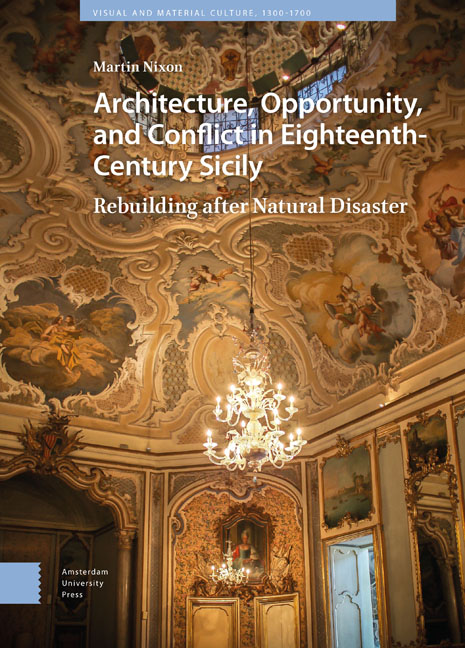 Architecture, Opportunity, and Conflict in Eighteenth-Century Sicily
Architecture, Opportunity, and Conflict in Eighteenth-Century Sicily Published online by Cambridge University Press: 24 November 2023
Abstract: The fortified hill town of Noto was rebuilt after the 1693 earthquake on a new flat site with streets lined with classicising facades whose understated ornament exudes moderation and harmony. However, this elegant new town was the result of bitter discord and opportunism as aristocratic factions secured sites for their palaces. The chapter focuses first on Noto's main square, where the leading aristocrats repositioned themselves with new palaces and tried to marginalise the locations of rivals. Then it discusses the palace facades as part of an aristocratic family's urban presence, in particular the Palazzo Nicolaci, built by a merchant family whose palace, with its defiant flowering ornament and enigmatic sculpture, challenges the understated facades of the town's older aristocracy.
Keywords: rebuilding of Noto, eighteenth-century palaces, architectural facades, architectural ornament, European urbanism, Southern Italy.
‘An Archipelago of Different Powers’: Contested Power Relations in the Rebuilding of Noto
Noto is often described as the most beautiful of the UNESCO-listed towns of the Val di Noto in Sicily. Designed by Angelo Italia, architect of the hexagonal town of nearby Avola, its principal streets are lined with elegant palace and church facades of honey-coloured stone whose delicate and understated ornament exudes moderation and harmony. Cesare Brandi describes Noto as ‘a garden of stone’ with a completely planned urbanism. John Ide, visiting in the 1950s, entitled his description Noto, the Perfect Baroque City. Noto is ‘a vision of restrained and harmonious Baroque architecture’. Ide compares the town to the aristocratic residences of Würzburg and Nymphenburg, locating Noto within a network of refined culture and quoting a description of the town as ‘one of the finest achievements of the age which produced Mozart and Tiepolo’. Studies by Tobriner and Canale describe Noto in terms of scenography, an eighteenth-century architectural programme that places buildings and streets in relation to each other so that a town is experienced as a series of views.
However, the new Noto emerged from a process of discord and opportunism as aristocratic factions secured sites for their new palaces. The energy spent on acquiring these sites shows how central the palace was for aristocratic status and how important the palace's location was in a town with many rival families at a time of great change and crisis caused by the earthquake.
To save this book to your Kindle, first ensure [email protected] is added to your Approved Personal Document E-mail List under your Personal Document Settings on the Manage Your Content and Devices page of your Amazon account. Then enter the ‘name’ part of your Kindle email address below. Find out more about saving to your Kindle.
Note you can select to save to either the @free.kindle.com or @kindle.com variations. ‘@free.kindle.com’ emails are free but can only be saved to your device when it is connected to wi-fi. ‘@kindle.com’ emails can be delivered even when you are not connected to wi-fi, but note that service fees apply.
Find out more about the Kindle Personal Document Service.
To save content items to your account, please confirm that you agree to abide by our usage policies. If this is the first time you use this feature, you will be asked to authorise Cambridge Core to connect with your account. Find out more about saving content to Dropbox.
To save content items to your account, please confirm that you agree to abide by our usage policies. If this is the first time you use this feature, you will be asked to authorise Cambridge Core to connect with your account. Find out more about saving content to Google Drive.